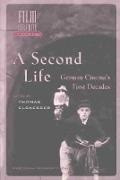Read more
German cinema is best known for its art cinema and its long line of outstanding individual directors. The double spotlight on these two subject has only deepened the obscurity surrounding the popular cinema. German Cinema performs a kind of archaeology on a period largely overlooked: the first two decades of German cinema. This collection of essays by established authors refocuses the terms of a debate that will develop in the years to come concerning the historical and cultural significance of popular cinema in Wilhelmine Germany.
List of contents
CONTENTS - 6 Preface and Acknowledgements - 8 General Introduction - 10 Early German Cinema: A Second Life? - 10 SECTION I: AUDIENCES AND THE CINEMA INDUSTRY - 40 The Kaiser's Cinema: An Archeology of Attitudes and Audiences - 42 Oskar Messter, Film Pioneer: Early Cinema between Science, Spectacle, and Commerce - 52 The French Connection: Franco-German Film Relations before World War I - 63 The Danish Influence: David Oliver and Nordisk in Germany - 73 Paul Davidson, the Frankfurt Film Scene and AFGRUNDEN in Germany - 80 Munich's First Fiction Feature: DIE WAHRHEIT - 87 Moving Images of America in Early German Cinema - 94 SECTION II: POPULAR STARS AND GENRES - 102 Comedy - 104 Early German Film Comedy, 1895-1917 - 104 The Spectator as Accomplice in Ernst Lubitsch's SCHUHPALAST PINKUS - 115 Melodrama and Social Drama - 119 Asta Nielsen and Female Narration: The Early Films - 119 Melodrama and Narrative Space: Franz Hofer's HEIDENROSLEIN - 124 Crime Drama and Detective Film - 133 Cinema from the Writing Desk: Detective Films in Imperial Germany - 133 Ernst Reicher alias Stuart Webbs: King of the German Film Detectives - 143 The Early Fantasy Film - 152 The Faces of Stellan Rye - 152 HOMUNCULUS: A Project for a Modern Cinema - 161 Non-Fiction: War Films, Industrial Films, Propaganda and Advertising - 169 Julius Pinschewer: A Trade-mark Cinema - 169 Newsreel Images of the Military and War, 1914-1918 - 176 Learning from the Enemy: German Film Propaganda in World War I - 186 The Reason and Magic of Steel: Industrial and Urban Discourses in DIE POLDIHUTTE - 193 SECTION III: FILM STYLE AND INTERTEXTS: AUTHORS, FILMS, AND AUTHORS' FILMS - 204 Max Mack: The Invisible Author - 206 From Peripetia to Plot Point: Heinrich Lautensack and ZWEIMAL GELEBT - 214 Giuseppe Becce and RICHARD WAGNER: Paradoxes of the First German Film Score - 220 Early German Film: The Stylistics in Comparative Context - 226 Self-Referentiality in Early German Cinema - 238 Of Artists and Tourists: 'Locating' Holland in Two Early German Films - 247 Stylistic Expressivity in DIE LANDSTRASSE - 257 Two 'Stylists' of the Teens: Franz Hofer and Yevgenii Bauer - 265 The Voyeur at Wilhelm's Court: Franz Hofer - 278 Notes - 286 Bibliography - 338 Publication Acknowledgements - 347 List of Contributors - 350
About the author
Thomas Elsaesser is Professor of the Department of Film and Television Studies at the Universiteit van Amsterdam and General Editor of the series Film Culture in Transition.

